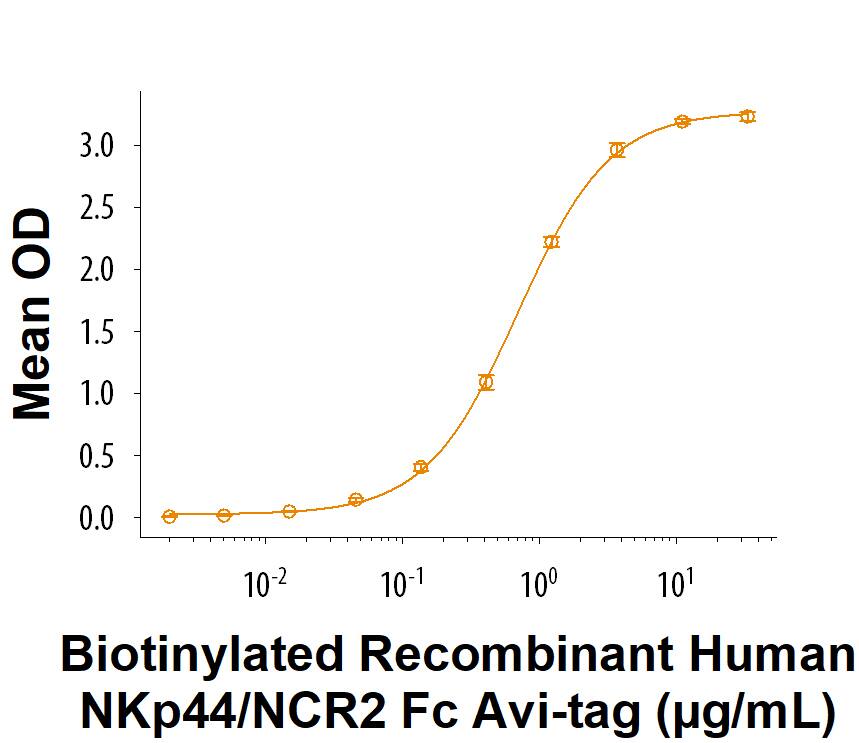Recombinant Human NKp44/NCR2 Fc Chimera Avi-tag Protein, CF
R&D Systems, part of Bio-Techne | Catalog # AVI2249

Key Product Details
Source
Accession #
Structure / Form
Biotinylated via Avi-tag
Conjugate
Applications
Product Specifications
Source
| Human NKp44 (Gln22-Pro190) Accession # CAB52289.1 |
IEGRMD | Human IgG1 (Pro100-Lys330) |
Avi-tag |
| N-terminus | C-terminus | ||
Purity
Endotoxin Level
N-terminal Sequence Analysis
Predicted Molecular Mass
SDS-PAGE
Activity
When Recombinant Human PDGF-DD (Catalog # 1159-SB/CF) is immobilized at 0.5 µg/mL (100 µL/well), Biotinylated Recombinant Human NKp44/NCR2 Fc Chimera Avi-tag (Catalog # AVI2249) binds with an ED50 of 0.200-1.60 µg/mL.
Scientific Data Images for Recombinant Human NKp44/NCR2 Fc Chimera Avi-tag Protein, CF
Recombinant Human NKp44/NCR2 Fc Chimera Avi-tag Protein Binding Activity.
When Recombinant Human PDGF-DD (1159-SB/CF) is immobilized at 0.5 µg/mL (100 µL/well), Biotinylated Recombinant Human NKp44/NCR2 Fc Chimera Avi-tag (Catalog # AVI2249) binds with an ED50 of 0.200-1.60 µg/mL.Recombinant Human NKp44/NCR2 Fc Chimera Avi-tag Protein SDS-PAGE.
2 μg/lane of Recombinant Human NKp44/NCR2 Fc Chimera Avi-tag Protein (Catalog # AVI2249) was resolved with SDS-PAGE under reducing (R) and non-reducing (NR) conditions and visualized by Coomassie® Blue staining, showing bands at 60-70 kDa and 120-150 kDa, respectively.Formulation, Preparation and Storage
AVI2249
| Formulation | Lyophilized from a 0.2 μm filtered solution in PBS with Trehalose. |
| Reconstitution | Reconstitute at 500 μg/mL in PBS. |
| Shipping | The product is shipped at ambient temperature. Upon receipt, store it immediately at the temperature recommended below. |
| Stability & Storage | Use a manual defrost freezer and avoid repeated freeze-thaw cycles.
|
Background: NKp44/NCR2
NKp44, along with NKp30 and NKp46, constitute a group of receptors termed "Natural Cytotoxicity Receptors" (NCR) (1). These receptors are expressed almost exclusively by NK cells and play a major role in triggering NK-mediated killing of most tumor cell lines. No rodent ortholog to NKp44 has been identified. Human NKp44, also known as NCR2, is a 44 kDa type I transmembrane glycoprotein that is characterized by the presence of one extracellular V-like immunoglobulin domain (2). It is synthesized as a 276 amino acid (aa) precursor that contains a 21 aa signal sequence, a 171 aa extracellular region, a 21 aa transmembrane segment and a 63 aa cytoplasmic tail. Alternate splicing in both the cytoplasmic tail and extracellular region generates multiple isoforms of unknown significance. The Ig-like region is unaffected. A physical association with the ITAM-bearing accessory protein, DAP12, occurs via a charged residue in the NKp44 transmembrane domain. Ligation of NKp44 with a specific antibody results in phosphorylation of DAP12 (3) and activation of target cell lysis in a redirected killing assay (4). NKp44 is absent from resting NK cells but is upregulated upon activation with IL-2. Activation-induced expression occurs in the CD56dim CD16+ NK subset that accounts for more than 85% of NK cells found in peripheral blood and spleen, as well as the CD56bright CD16- NK subset that constitutes the majority of NK cells in lymph node and tonsil (5). Studies with neutralizing antibodies reveal that NKp44 is partially responsible for triggering lytic activity against several tumor cell types (2, 6). Blocking any of the individual NCRs results in partial inhibition of tumor cell lysis, but nearly complete inhibition of lysis is observed if all three receptors are blocked simultaneously (6). NKp44 has also been implicated in recognition of virus-infected cells through its capacity to bind to viral hemagglutinins (7). Our Avi-tag Biotinylated human NKp44/NCR2 Fc chimera features biotinylation at a single site contained within the Avi-tag, a unique 15 amino acid peptide. Protein orientation will be uniform when bound to streptavidin-coated surface due to the precise control of biotinylation and the rest of the protein is unchanged so there is no interference in the protein's bioactivity.
References
- Moretta, L. and A. Moretta (2004) EMBO J. 23:255.
- Cantoni, C. et al. (1999) J. Exp. Med. 189:787.
- Augugliaro, R. et al. (2003) Eur. J. Immunol. 33:1235.
- Vitale, M. et al. (1998) J. Exp. Med. 187:2065.
- Ferlazzo, G. et al. (2004) J. Immunol. 172:1455.
- Pende, D. et al. (1999) J. Exp. Med. 190:1505.
- Arnon, T. et al. (2001) Eur. J. Immunol. 31:2680.
Long Name
Alternate Names
Gene Symbol
UniProt
Additional NKp44/NCR2 Products
Product Documents for Recombinant Human NKp44/NCR2 Fc Chimera Avi-tag Protein, CF
Product Specific Notices for Recombinant Human NKp44/NCR2 Fc Chimera Avi-tag Protein, CF
For research use only

